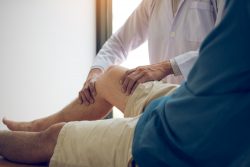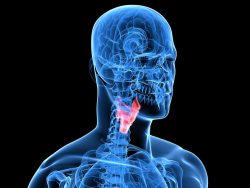Goji Berries May Provide Protection Against Age Related Loss of Vision
 A new small randomized trial has shown that consuming a small amount of dried goji berries on a regular basis may help delay or prevent developing age related macular degeneration or AMD. It is the leading cause of loss of vision in the older population and is estimated to affect over 1 million in the U.S. and 170 million throughout the world. It is a condition that affects the central field of vision and the ability to recognize faces or read.
A new small randomized trial has shown that consuming a small amount of dried goji berries on a regular basis may help delay or prevent developing age related macular degeneration or AMD. It is the leading cause of loss of vision in the older population and is estimated to affect over 1 million in the U.S. and 170 million throughout the world. It is a condition that affects the central field of vision and the ability to recognize faces or read.
In this study, healthy participants between the ages of 45 to 65 ate 27 grams or about one ounce of goji berries 5 times per week for a period of 90 days. The team found this increased the density of protective pigments in their eyes. In contrast, 14 study participants who consumed a commercial supplement throughout the same period did not show any increase.
The particular pigments that increased in the group who consumed the goji berries were zeaxanthin and lutein. These are known to provide antioxidant protection and filter out blue light that is harmful. Both pigments help protect the eyes while we age. They are like sunscreen for the eyes. The higher these pigments are in the retina, the more protection is provided.
The study discovered that even in normal healthy eyes, zeaxanthin and lutein can be increased with a small serving of goji berries eaten daily.
Goji berries are a fruit that comes from shrubby bushes found in Northwest China. The dried goji berries are a popular ingredient in Chinese soups and are also popular as a herbal tea. They are close to raisins when consumed as a snack.
Bioactive compounds were researched in goji berries and it was found they contain high levels of zeaxanthin and lutein. The zeaxanthin form in goji berries is a highly bioavailable form meaning it is easily absorbed in the digestive system so the body is able to use it.
Currently, the treatments for intermediate stages of AMD include using AREDS which are special dietary supplements that contain vitamins E, C copper, lutein and zeaxanthin. There isn’t any known therapy at this time that has been shown to help with early stages of AMD.
The cause of AMD is multifactorial and complex and involves a mix of genetic risks, diet, smoking, sun exposure and age related changes. Early stages do not have symptoms, however it can be detected by a physician along with other problems in a regular and comprehensive eye examination.
The study shows that goji berries which are a natural food source can improve macular pigments of healthy people beyond the intake of high doses of nutritional supplements.
The next part of the study is to examine goji berries in people with early stage AMD. The results of the current study are promising, however the team notes that the study was small and additional research is required.
To view the original scientific study click below:
Goji Berry Intake Increases Macular Pigment Optical Density in Healthy Adults: A Randomized Pilot Trial



 The American Heart Association has presented research that stem cell therapy can help people that have chronic, high-risk heart failure reduce future occurrences.
The American Heart Association has presented research that stem cell therapy can help people that have chronic, high-risk heart failure reduce future occurrences.  Zero gravity conditions found in space may be the secret to mass producing stem cells with life saving advances here on earth.
Zero gravity conditions found in space may be the secret to mass producing stem cells with life saving advances here on earth. As we age our muscles become weaker and smaller and not able to heal as well after an injury. Researchers in a new study have made an important discovery to keep muscles in mice youthful. This discovery could advance the regeneration of muscle therapies for the older population.
As we age our muscles become weaker and smaller and not able to heal as well after an injury. Researchers in a new study have made an important discovery to keep muscles in mice youthful. This discovery could advance the regeneration of muscle therapies for the older population. An unhealthy diet can increase the risk for diabetes, obesity, and gastrointestinal cancer. Researchers have discovered some new insights that help them better understand the connection between the molecular mechanisms responsible for this. The findings open an avenue for developing non-invasive therapies.
An unhealthy diet can increase the risk for diabetes, obesity, and gastrointestinal cancer. Researchers have discovered some new insights that help them better understand the connection between the molecular mechanisms responsible for this. The findings open an avenue for developing non-invasive therapies. While it may be hard to fit nutritious meals into a busy day especially for someone who works late hours, it appears that eating at nighttime could be bad for your health.
While it may be hard to fit nutritious meals into a busy day especially for someone who works late hours, it appears that eating at nighttime could be bad for your health.  Scientists at Monash University in Australia have discovered a new enzyme that works to improve our health through exercise. Promoting the enzyme’s activity helps protect against the results of aging, improves metabolic health and can reduce type 2 diabetes.
Scientists at Monash University in Australia have discovered a new enzyme that works to improve our health through exercise. Promoting the enzyme’s activity helps protect against the results of aging, improves metabolic health and can reduce type 2 diabetes. A new stem cell treatment has been developed to cure type 1 diabetes. An ongoing clinical trial by Vertex Pharmaceuticals has successfully treated the first patient. He had been living with type 1 diabetes for 40 years and was dependent on insulin.
A new stem cell treatment has been developed to cure type 1 diabetes. An ongoing clinical trial by Vertex Pharmaceuticals has successfully treated the first patient. He had been living with type 1 diabetes for 40 years and was dependent on insulin. A new clinical research project has shown that the commonly used food additive carboxymethylcellulose will alter a healthy person’s intestinal environment. This will upset the levels of nutrients and good bacteria. The findings indicate that there needs to be further study on the impact of this food additive on the health of people.
A new clinical research project has shown that the commonly used food additive carboxymethylcellulose will alter a healthy person’s intestinal environment. This will upset the levels of nutrients and good bacteria. The findings indicate that there needs to be further study on the impact of this food additive on the health of people. Through the combination of physics, chemistry, engineering and biology, researchers have developed a biomaterial that is strong enough to repair muscles, vocal cords and the heart. This is a significant advance in regenerative medicine.
Through the combination of physics, chemistry, engineering and biology, researchers have developed a biomaterial that is strong enough to repair muscles, vocal cords and the heart. This is a significant advance in regenerative medicine.